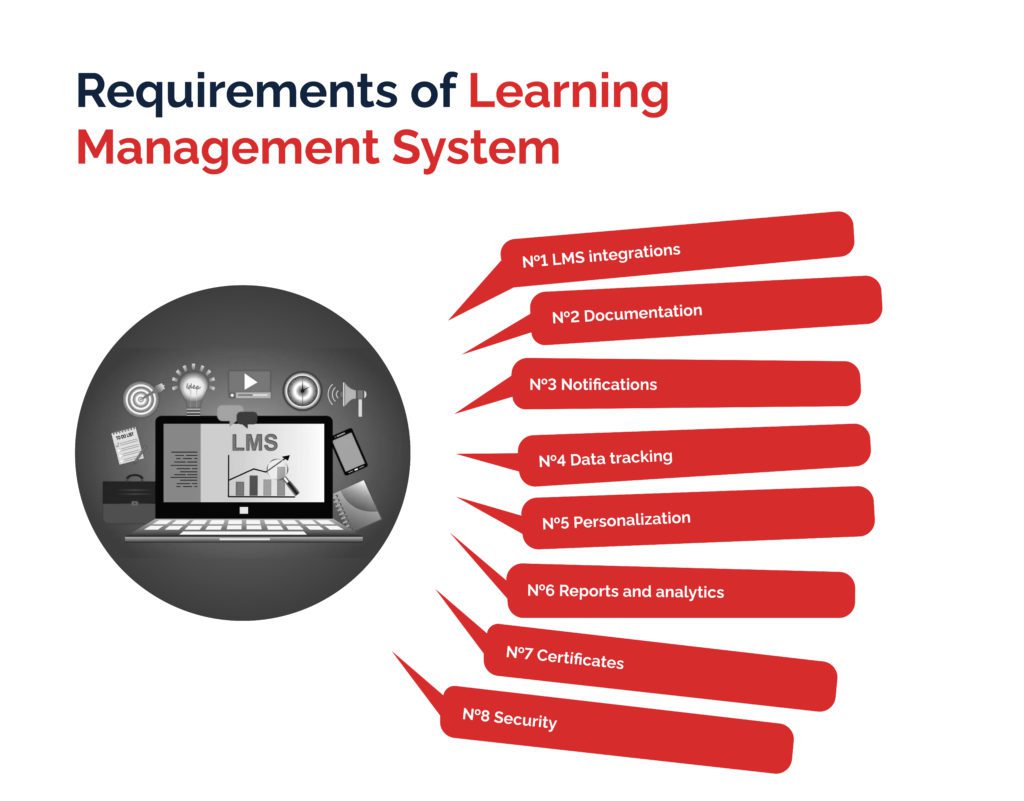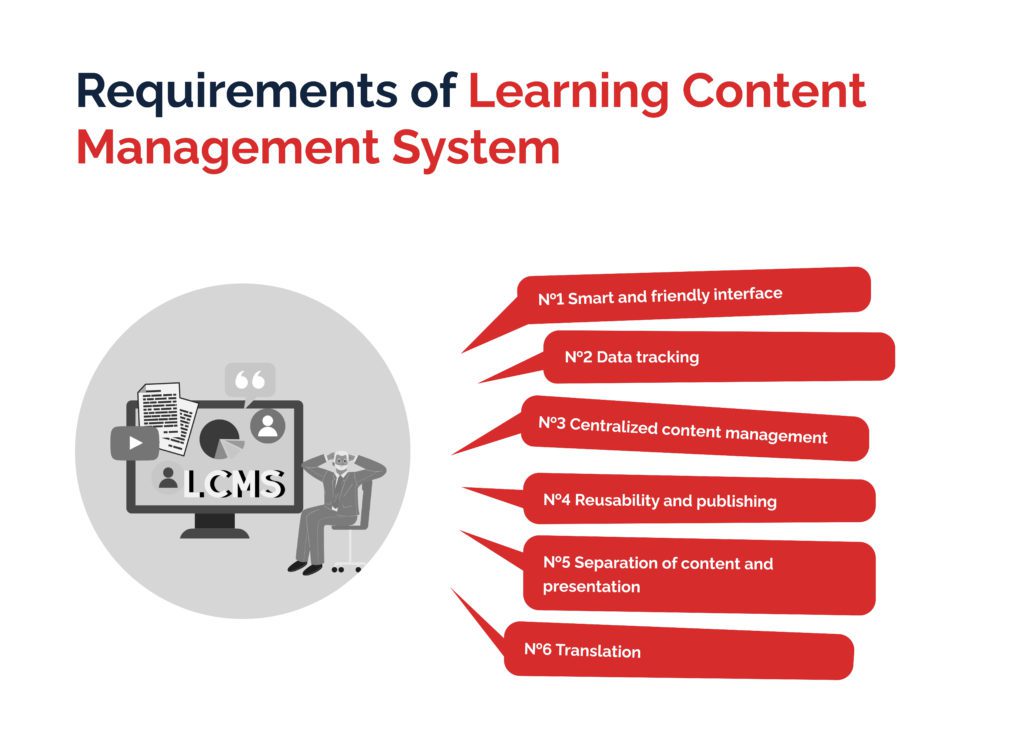LCMS and LMS are terms that appear to be very similar, but there are some significant divergences behind them. In this article, we, thus, look at the LMS vs. LCMS similarities and differences.
Google shows many search requests on LMS and LCMS, their features, differences, and benefits. Each article differs, covering different subquestions. Today, we’ll provide detailed responses to help you clearly understand what you need for your business.
What Is an LMS?
LMS is a software-based or SaaS platform that assists teachers with creating, administering, and delivering e-learning courses, training or development programs, and other educational content. You can access most LMSes today via a mobile device.

LMS is a powerful learning technology solution because it enables scalability and has a flexible range of standard compliance functions for individual learners and teachers. It’s used not only in education or business but in any industry where there’s a need for deploying adaptive learning strategies. LMS has no limits; it covers many goals, including formal, experiential, and social learning management. If compared with LCMS, its audience isn’t limited. LMS is used by learners, administrators, educators, business owners, officials, and anyone who wants to evolve training needs inside a specific institution through a centralized platform.
Key LMS features
What features are essential for a high-quality LMS framework? Here are some core elements that instructional designers need to add for their systems to succeed.
№1. LMS integrations
Integration is always beneficial for content delivery systems. An LMS that is well-integrated with other systems can receive vital information and content quickly.
№2. Documentation
LMS frameworks are good not only at improving the learning experiences but also regarding supplementary tasks. These systems simplify the administrative processes for instructional designers. For example, they collect all information on the student scores within one centralized location, minimizing the pressure on the administrative staff.
№3. Notifications
Notifications remind learners about their course assignments and important events. This technology is perfect when you need to announce some changes in your training materials or, for example, change the date of some exams.
№4. Data tracking
Data analysis is among the core demands for modern training programs. This technology is the best way to diagnose various types of learning systems and review their efficiency levels. If there are some apparent struggles in understanding course materials among individual learners, a high-quality data tracking system can quickly discover them and help the relevant decision-makers take action before the problems become potent.
Main LMS benefits
Modern Learning Management Systems are notable for a wide set of benefits with respect to online learning. Let’s review the top three positives one should consider:
1) Centralized access to content. Learning Management Systems are renowned for providing centralized repositories for all types of digital learning content. One can easily store whole courses and the adjacent content for them on those platforms. Why is this so vital? Using LMSes, learners can access learning materials in any location and at any time.
2) Progress tracking and reporting: modern LMSes collect significant amounts of information about the relevant learners. In practice, this means that they allow modern schools and other education facilities to gather so-called Big Data. By analyzing this Big Data, schools, and other facilities can then make high-quality decisions about online training content changes or, for example, personalized learning experiences. Data-driven decision-making is, ultimately, one of the core benefits of the presented technology.
3) High-quality communication and collaboration tools. Traditional classroom learning is typically considered superior in terms of communication and collaboration because it enables natural, real-life interactions. However, there are significant reasons to dispute this opinion with the rise of LMSes. Modern Learning Management Systems offer great content creation software for student projects and enable efficient communication via chats and forums.
What Is an LCMS?

LCMS, a learning content management system, offers a collaborative environment for those involved in content creation. Some core stakeholders for those systems include educators, content authors, administrators, managers, and designers. LCMS refers to the web-based space that allows one to manage the development of educational material. These platforms are valuable for their functions that enable managers to regulate content effectively by using built-in resources, templates, and other tools.
Key LCMS features
Now that we understand what LCMSes as advanced authoring tools are, let’s look at the core features of those frameworks. So, here is a list of must-have requirements for an efficient LCMS:
№1. Smart and friendly interface
You may think this requirement is obvious, but it’s often neglected by existing firms on the market. A good user interface guarantees attention from various training managers who need easy-to-use but advanced tools for their platforms.
№2. Data tracking
This feature is also highly essential. A good learning management system needs to have the ability to pull data easily and analyze learners’ and employees’ activity. Why? With data tracking, you can identify which areas the learners excel in and determine their needs for additional training.
№3. Centralized content management
Centralization prevents content duplication and maintenance problems. It allows content managers to create, store, and monitor learning material faster and more efficiently.
№4. Reusability and publishing
Learning content management systems use XML, making content transfers between different platforms easy. Standards like SCORM or AICC prevent situations in which a school or business becomes unavoidably reliant on just one learning platform.
№5. Localization
LCMS platforms should also have strong tools for localization. One should be able to easily add subtitles or change certain images. In this way, they allow schools and colleges to spread their online content to a more significant number of people. Courses like CS50 became so popular across the globe thanks to this feature.
Main LCMS benefits
In our opinion, modern LCMS platforms have several vital benefits that decision-makers need to consider:
1) Centralized platform for content: LCMS is notable for organizing all learning content in one place. As a result, any educator team can quickly find and use the information they need for their lessons.
2) Streamlined content creation: a major problem stemming from LMSes is that they don’t offer sufficient tools for creating content. LCMSes solve this issue by giving multiple ways to organize e-learning content and exercises. For example, they provide high-quality programming tools for creating unique student-oriented tasks. In this way, LCMSes offer unified frameworks for all teacher activities.
3) Content reusability: LCMSes also feature a wide number of standards, such as SCORM and AICC. These standards are highly important because they prevent vendor lock-ins. One can change an LCMS platform easily by importing their project into a common standard. Thus, LCMSes are notable for training platform interoperability, which may be absent in some custom-made proprietary LMSes.
LMS vs. LCMS: Similarities and Differences
LMS and LCMS have both similar and different goals and functions. Let’s see how they affect corporate training and what’s the difference in their impacts:
Content management vs. content creation
LMS focuses on delivering training courses and managing them. These systems are used for administering, documenting, tracking, and reporting on the delivery of courses.
LCMS is more focused on content creation and management. Systems of this type help create, manage, store, organize, and publish content in various formats. Some LCMSs allow tracking the performance but with some limitations.
Functionality
A typical LMS assists in creating a personalized learning path based on the learners’ skills and progress. It also offers courses for learners by managing competency and certification.
LCMSes allow collaborative authoring for content creation. They provide shared media libraries, templates, APIs, and workflow management tools. With LCMSes, the users can reuse the content and get usage reports.
In short, both platforms are similar in the sense that they help organize learning. Here’s a full list of their core similarities:
- accelerated efficiency of the learning process;
- built-in libraries, templates, and resources;
- advanced search option;
- analytics and reports;
- mobile compatibility;
- e-learning management;
- reusability of content;
- results and progress tracking.
Users
Typical LMS users are instructors, managers, learners, and anyone involved in learning.
In turn, a typical LCMS user is a content creator.
Which Solution to Choose?
In our opinion, everything depends on the goals of your company or education institution in this LMS vs. LCMS competition. On the one hand, an LMS is great when you already have content and need to upload it into some platform for student-oriented management. On the other hand, an LCMS is essential in situations when you require advanced authoring tools to deliver high-quality training programs aimed at LMS usage. Hence, LMS vs. LCMS contest is usually a non-issue: most organizations need the platforms of both types.
FAQs
What does the term LCMS mean?
LCMS is a learning content management system. It’s a system for creating and managing learning materials.
What do LMSes stand for?
These are Learning Management Systems. Their goal is to help with organizing the learning process.
What people require an LMS?
An LMS is typically needed by teachers and administrators, who work directly with students.
What people require an LCMS?
Such systems are typically required by content creators, such as teachers, who want to create unique author-oriented courses.
Address Keenethics, and we’ll provide you with qualified expert help.












